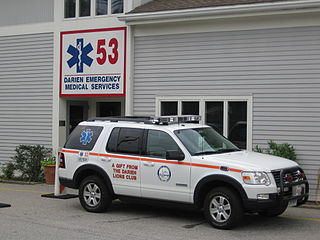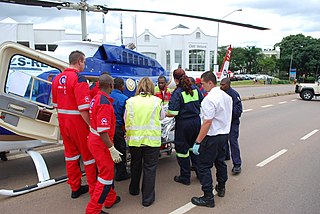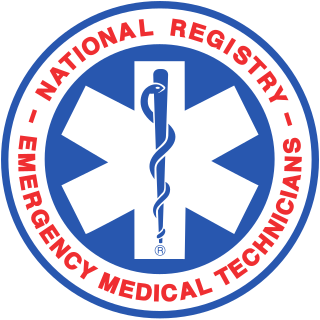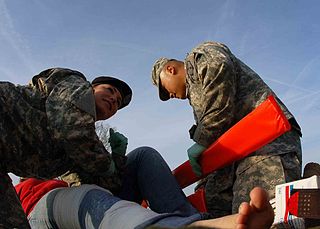Related Research Articles

Emergency medical services (EMS), also known as ambulance services or paramedic services, are emergency services that provide urgent pre-hospital treatment and stabilisation for serious illness and injuries and transport to definitive care. They may also be known as a first aid squad, FAST squad, emergency squad, ambulance squad, ambulance corps, life squad or by other initialisms such as EMAS or EMARS.

An emergency medical technician is a medical professional that provides emergency medical services. EMTs are most commonly found serving on ambulances and in fire departments in the US and Canada, as full-time and some part-time departments require their firefighters to be EMT certified.

A paramedic is a healthcare professional trained in the medical model, whose main role has historically been to respond to emergency calls for medical help outside of a hospital. Paramedics work as part of the emergency medical services (EMS), most often in ambulances. They also have roles in emergency medicine, primary care, transfer medicine and remote/offshore medicine. The scope of practice of a paramedic varies between countries, but generally includes autonomous decision making around the emergency care of patients.

A certified first responder is a person who has completed a course and received certification in providing pre-hospital care for medical emergencies. Certified individuals should have received much more instruction than someone who is trained in basic first aid and cardiopulmonary resuscitation (CPR) but they are not necessarily a substitute for more advanced emergency medical care rendered by emergency medical technicians and paramedics. First responders typically provide advanced first aid level care, CPR, and automated external defibrillator (AED) usage. The term "certified first responder" is not to be confused with "first responder", which is a generic term referring to the first medically trained responder to arrive on scene and medically trained telecommunication operators who provide pre-arrival medical instructions as trained Emergency Medical Dispatchers (EMD). Many police officers and firefighters are required to receive training as certified first responders. Advanced medical care is typically provided by EMS, although some police officers and firefighters also train to become emergency medical technicians or paramedics.
The Seattle & King County Emergency Medical Services System is a fire-based two-tier response system providing prehospital basic and advanced life support services.

The California Emergency Medical Services Authority is an agency of California State government. The California EMS Authority is one of the thirteen departments within the California Health and Human Services Agency. The director is required to be a physician with substantial experience in emergency medicine. Elizabeth Basnett is the current Acting Director.

In the United States, the paramedic is a allied health professional whose primary focus is to provide advanced emergency medical care for patients who access Emergency Medical Services (EMS). This individual possesses the complex knowledge and skills necessary to provide patient care and transportation. Paramedics function as part of a comprehensive EMS response under physician medical direction. Paramedics often serve in a prehospital role, responding to Public safety answering point (9-1-1) calls in an ambulance. The paramedic serves as the initial entry point into the health care system. A standard requirement for state licensure involves successful completion of a nationally accredited Paramedic program at the certificate or associate degree level.
Advanced Emergency Medical Technician - Critical Care (AEMT-CC) is a former Emergency Medical Services (EMS) certification that was unique to New York. The curriculum for AEMT-CC's in New York was similar to that of the national standard EMT-I/99 but with a broader scope of practice. EMT-CCs are fully classified as Advanced Life Support (ALS) providers within New York and are trained in advanced airway management, including intubation, IV fluid administration, cardiac monitoring, cardiac pacing, and both synchronized and unsynchronized cardioversion, and medication usage/administration in adult and pediatric patients.

Louisville Metro Emergency Medical Services is the primary provider of pre-hospital life support and emergency care within Louisville-Jefferson County, Kentucky. LMEMS is a governmental department that averages 90,000 calls for service, both emergency and non-emergency, each year.

In the United States, emergency medical services (EMS) provide out-of-hospital acute medical care and/or transport to definitive care for those in need. They are regulated at the most basic level by the National Highway Traffic Safety Administration, which sets the minimum standards that all states' EMS providers must meet, and regulated more strictly by individual state governments, which often require higher standards from the services they oversee.
In the US, paramedicine is the physician-directed practice of medicine, often viewed as the intersection of health care, public health, and public safety. While discussed for many years, the concept of paramedicine was first formally described in the EMS Agenda for the Future. Paramedicine represents an expansion of the traditional notion of emergency medical services as simply an emergency response system. Paramedicine is the totality of the roles and responsibilities of individuals trained and credentialed as EMS practitioners. These practitioners have been referred to as various levels of Emergency Medical Technician (EMTs). In the United States paramedics represent the highest practitioner level in this domain. Additional practitioner levels in this domain within the U.S. include Emergency Medical Responders (EMRs), Emergency Medical Technicians (EMTs) and Advanced Emergency Medical Technicians (AEMTs).

Emergency medical services in South Africa are a public/private system aimed at the provision of emergency ambulance service, including emergency care and transportation to hospital.

The National Registry of Emergency Medical Technicians is a US certification agency covering prehospital medical providers.
An advanced emergency medical technician is a provider of emergency medical services in the United States. A transition to this level of training from the emergency medical technician-intermediate, which have somewhat less training, began in 2013 and has been implemented by most states. AEMTs are not intended to deliver definitive medical care in most cases, but rather to augment prehospital critical care and provide rapid on-scene treatment. AEMTs are usually employed in ambulance services, working in conjunction with EMTs and paramedics; however they are also commonly found in fire departments and law enforcement agencies as non-transporting first responders. Ambulances operating at the AEMT level of care are commonplace in rural areas, and occasionally found in larger cities as part of a tiered-response system, but are overall much less common than EMT- and paramedic-level ambulances. The AEMT provides a low-cost, high-benefit option to provide advanced-level care when the paramedic level of care is not feasible. The AEMT is authorized to provide limited advanced life support, which is beyond the scope of an EMT.
Emergency Medical Technician is the entry level of Emergency Medical Technician in the United States.

Emergency medical responders are people who are specially trained to provide out-of-hospital care in medical emergencies, typically before the arrival of an ambulance. Specifically used, an Emergency Medical Responder is an EMS certification level used to describe a level of EMS provider below that of an emergency medical technician and paramedic. However, the EMR is not intended to replace the roles of such providers and their wide range of specialties.
Emergency medical services in Sri Lanka is being established using a public/private system aimed at the provision of emergency ambulance service, including emergency care and transportation to hospitals. The Pre-Hospital Care Committee is part of the Trauma Secretariat of the Sri Lanka Ministry of Healthcare and Nutrition and was established following the 2004 tsunami. The goal of the Pre-Hospital Care Sub-Committee is “During this generation and continuing for future generations, everyone in Sri Lanka will have access to trained pre-hospital medical personnel, ambulances are available to transport the sick and injured safely to hospitals, complications from harmful or inadequate pre-hospital care is eliminated so physician and nursing personnel at hospitals are delivered patients they are able to professionally treat and rehabilitate back to society as contributing citizens.” Pre-Hospital care is an essential, core component of trauma system.
Intermediate Life Support (ILS) is a level of training undertaken in order to provide emergency medical care outside medical facilities. ILS is classed as mid-level emergency medical care provided by trained first responders who receive more training than basic life support providers, but less than advanced life support providers. Intermediate Life Support is also known as Limited Advanced Life Support (LALS), Immediate Life Support, or Intermediate Advanced Life Support (IALS).

The Recognition of EMS Personnel Licensure Interstate CompAct, also known as REPLICA, is an interstate compact that extends a "privilege to practice" in the United States from a 'home state' to 'remote states' for qualified Emergency Medical Services personnel. For a state to participate in the compact, a state must pass the model legislation into law. On October 11, 2017, when Georgia signed the REPLICA legislation into law, the EMS Compact was formalized and the Interstate Commission for EMS Personnel Practice was established.
References
- ↑ "National Standard Curriculum" (PDF). National Highway Transportation Safety Administration. Archived from the original (PDF) on 2021-03-24. Retrieved 2014-09-07.
- ↑ "About NREMT Examinations". National Registry of Emergency Medical Technicians. Retrieved 2014-09-08.
- ↑ "2011 Annual Report" (PDF). National Registry of Emergency Medical Technicians. p. 11. Retrieved 2012-11-11.
- ↑ "EMT Certification - FAQs: How do I gain certification in Arizona as an EMT-B, EMT-I, or EMT-P?". Arizona Department of Public Health Services. Retrieved 2008-03-27.
- 1 2 "ARKANSAS STATE BOARD OF HEALTH SECTION OF EMERGENCY MEDICAL SERVICES : RULES AND REGULATIONS FOR EMERGENCY MEDICAL SERVICES" (PDF). Healthy.arkansas.gov. Retrieved 4 August 2019.
- 1 2 3 "ARKANSAS STATE BOARD OF HEALTH SECTION OF EMERGENCY MEDICAL SERVICES : SCOPE OF PRACTICE" (PDF). Healthy.arkansas.gov. Retrieved 4 August 2019.
- 1 2 3 "EMS Statues, Regulations, and Legislation". California Code of Regulations, Title 22. California Emergency Medical Services Authority. Archived from the original on 24 November 2011. Retrieved 5 December 2011.
- ↑ "Emergency medical responder (EMR) registration | Department of Public Health and Environment". www.colorado.gov. Retrieved 2017-10-27.
- ↑ "Intravenous Therapy And Medication Administration Course Curriculum" (PDF). Colorado Department of Public Health & Environment. 2015-03-01. Retrieved 2018-03-09.
- ↑ "Rules Pertaining to EMS Practice and Medical Director Oversity". Colorado Department of Public Health and Environment. Archived from the original (PDF) on 2014-09-08. Retrieved 2014-09-08.
- ↑ "EMS Provider Certification Frequently Asked Questions". Colorado Department of Public Health and Environment. Archived from the original (PDF) on 2014-11-06. Retrieved 2014-09-08.
- 1 2 3 4 "Emergency Medical Services - Licensure/Certification/Exams". Connecticut Department of Public Health. Retrieved 5 December 2011.
- ↑ "Delaware Paramedic Education" . Retrieved 11 November 2012.
- 1 2 "Emergency Medical Services Rules". Florida Administrative Code. Florida Department of State, Division of Library and Information Services. Retrieved 5 December 2011.
- ↑ "Georgia Office of EMS Course Approval-Initial Education for Licensure" (PDF). Ems.ga.gov. Retrieved 4 August 2019.
- ↑ "Certifying Emergency Medical Service Personnel". State of Hawaii. Retrieved 2008-03-27.
- ↑ "Idaho Emergency Medical Services Bureau". Idaho Department of Health and Welfare. Retrieved 8 September 2014.
- ↑ "EMS Licensing". dph.illinois.gov. Retrieved 15 September 2023.
- ↑ "Levels of EMS Personnel Certification" (PDF). Indiana Emergency Medical Services Commission. Retrieved 2008-03-27.
- ↑ "Authorized Iowa EMS Training Programs" (PDF). Iowa Department of Public Health, Bureau of Emergency Medical Services. Archived from the original (PDF) on 2006-02-24. Retrieved 2008-03-27.
- ↑ "Iowa EMT-Paramedic to Paramedic Specialist Transition Application" (PDF). Iowa Department of Public Health, Bureau of Emergency Medical Services. Archived from the original (PDF) on 2009-02-19. Retrieved 2008-03-27.
- ↑ "IDPH - Bureau of EMS" (PDF). Iowa EMS Transition. Iowa Department of Public Health. Archived from the original (PDF) on 6 April 2012. Retrieved 10 November 2011.
- ↑ "Frequently Asked Questions". Kansas Board of Emergency Medical Services. Archived from the original on 2008-02-19. Retrieved 2008-03-28.
- 1 2 3 4 5 "Scope of Practice". Kentucky Board of Emergency Medical Services. Retrieved 10 May 2024.
- ↑ "Certification & Licensure". Kentucky Board of Emergency Medical Services. Retrieved 10 May 2024.
- ↑ "Frequently Asked Questions". State of Louisiana, Department of Health and Hospitals, Louisiana Bureau of Emergency Medical Systems. Retrieved 2018-05-22.
- ↑ "Maine Emergency Medical System Rules" (PDF). p. 118. Retrieved 2014-09-16.
- ↑ "Maryland EMS Clinician Descriptions" (PDF). Maryland Emergency Medical Services System. 2021-02-10 [2019-08-13]. Retrieved 2022-09-30.
- ↑ "Overview of Training Requirements". Massachusetts Office of Health and Human Services. Retrieved 2008-03-28.
- ↑ "License Packet" (.PDF). Michigan Department of Community Health, Emergency Medical Services and Trauma System. p. 4. Retrieved 2008-03-28.
- ↑ "Certification". Minnesota Emergency Medical Services Regulatory Board. Archived from the original on 2008-04-13. Retrieved 2008-03-28.
- ↑ "144E.101 - 2014 Minnesota Statutes". www.revisor.mn.gov. Retrieved 2018-03-09.
- ↑ "EMS Personnel Information Frequently Asked Questions (FAQ)". Mississippi State Department of Health, Emergency Medical Services. Archived from the original on 2007-11-10. Retrieved 2008-03-28.
- ↑ "EMT and Paramedic Licensing Information". Missouri Department of Health and Senior Services. Retrieved 13 December 2020.
- ↑ "Certification for Out-of-Hospital Providers". Nebraska Department of Health and Human Services. Archived from the original on 2008-05-17. Retrieved 2008-03-28.
- ↑ "New Hampshire EMS Provider License Application" (PDF). Department of Safety. Retrieved 2008-03-28.
- ↑ "Mobility Assistance Vehicle and Basic Life Support Ambulance Services" (PDF). New Jersey Administrative Code . State of New Jersey. NJAC 8:40. Archived from the original (PDF) on 2011-07-19. Retrieved 2010-01-04.
- ↑ "Advanced Life Support Services; Mobile Intensive Care Programs, Specialty Care Transport Services and Air Medical Services" (PDF). New Jersey Administrative Code . State of New Jersey. NJAC 8:41. Archived from the original (PDF) on 2011-07-19. Retrieved 2010-01-04.
- ↑ "Emergency Medical Technicians-Paramedic: Training and certification" (PDF). New Jersey Administrative Code . State of New Jersey. NJAC 8:41A. Archived from the original (PDF) on 27 January 2012. Retrieved 5 December 2011.
- ↑ "NEW JERSEY ADMINISTRATIVE CODE 8:41R" (PDF). New Jersey Department of Health. Retrieved 10 October 2019.
- ↑ "Licensing Info". New Mexico Department of Health. Archived from the original on 24 January 2013. Retrieved 11 November 2012.
- ↑ "Emergency Medical Services Statistical Information". New York State Department of Health. Retrieved 2008-03-29.
- ↑ "NC DHSR OEMS: Credentialing and Compliance". www2.ncdhhs.gov. Retrieved 2018-03-09.
- ↑ "Training, Testing and Certification Requirements". North Dakota, Department of Health, Emergency Medical Services. Retrieved 2008-03-29.
- ↑ "Scope of Practice". Ohio Department of Public Safety, Ohio Emergency Medical Services. Archived from the original on 26 October 2012. Retrieved 11 November 2012.
- 1 2 3 4 "Licensure". EMT Licensure and Registration. Oklahoma State Department of Health. Archived from the original on 7 December 2011. Retrieved 5 December 2011.
- ↑ "Welcome to EMT Educational Requirements". Oregon Department of Human Services, Emergency Medical Services and Trauma Systems. Archived from the original on 2008-05-17. Retrieved 2008-03-29.
- ↑ "Emergency Medical Services Regulations 216-RICR-20-10-2". Rhode Island Secretary of State. State of Rhode Island. Retrieved 15 January 2021.
- ↑ "South Carolina Certification Process" (PDF). South Carolina Emergency Medical Services. Archived from the original (PDF) on 2008-01-02. Retrieved 2008-03-29.
- 1 2 "South Dakota Basic Life Support SCOPE of PRACTICE" (PDF). South Dakota Department of Health. 14 June 2018. Archived (PDF) from the original on 14 March 2019.
- ↑ "South Dakota Scope of Practice Guide for Advanced Life Support Personnel - EMT I/85, EMT-A, EMT I/99, EMT-P" (PDF). South Dakota Board of Medical and Osteopathic Examiners. 14 June 2018. Archived (PDF) from the original on 31 March 2022.
- ↑ "Critical Care Paramedic Standardized Modules and Objectives" (PDF). State of Tennessee Department of Health. Archived from the original (PDF) on 2008-02-04. Retrieved 2008-04-10.
- ↑ "Texas Administrative Code Rule §157.2". texreg.sos.state.tx.us. Retrieved 2018-03-09.
- ↑ "Requirements for initial certification/licensure". Texas Department of State Health Services. Retrieved 2008-03-27.
- 1 2 3 4 5 6 "EMT & Paramedic Certification". Utah EMT & Paramedic Certification. Utah Department of Health, Bureau of Emergency Medical Services. Retrieved 7 December 2011.
- ↑ "Vermont Statewide Emergency Medical Services Protocols" (PDF). Vermont Department of Health, Office of Emergency Medical Services. Retrieved 2018-03-09.
- ↑ "Critical Care Paramedic Update" (PDF). 2015-09-05. Retrieved 2018-03-09.
- ↑ "Transitioning to the new National EMS Scope of Practice and Education Standards". Virginia EMS Education Standards. Virginia Department of Health. Retrieved 10 November 2011.
- ↑ "Initial Certification Process". Washington State Department of Health, Office of Emergency Medical Services and Trauma System. Archived from the original on 2008-05-15. Retrieved 2008-03-29.
- ↑ "EMS Education and Curriculum Materials". West Virginia Department of Health and Human Resources. Office of Emergency Medical Services. Archived from the original on 2014-04-14. Retrieved 2014-04-13.
- ↑ "Wisconsin EMS Scope of Practice" (PDF).
- ↑ "First Responder Certification Process". Wisconsin Department of Health and Family Services, Emergency Medical Services. Retrieved 2012-11-11.
- ↑ "Critical Care Paramedic Endorsement" (PDF). Wisconsin Department of Health and Family Services, Emergency Medical Services. Retrieved 2014-04-13.
- ↑ "Certification Application". Wyoming Department of Health, Office of Emergency Medical Services. Archived from the original (pdf) on 2011-07-21. Retrieved 2008-03-29.